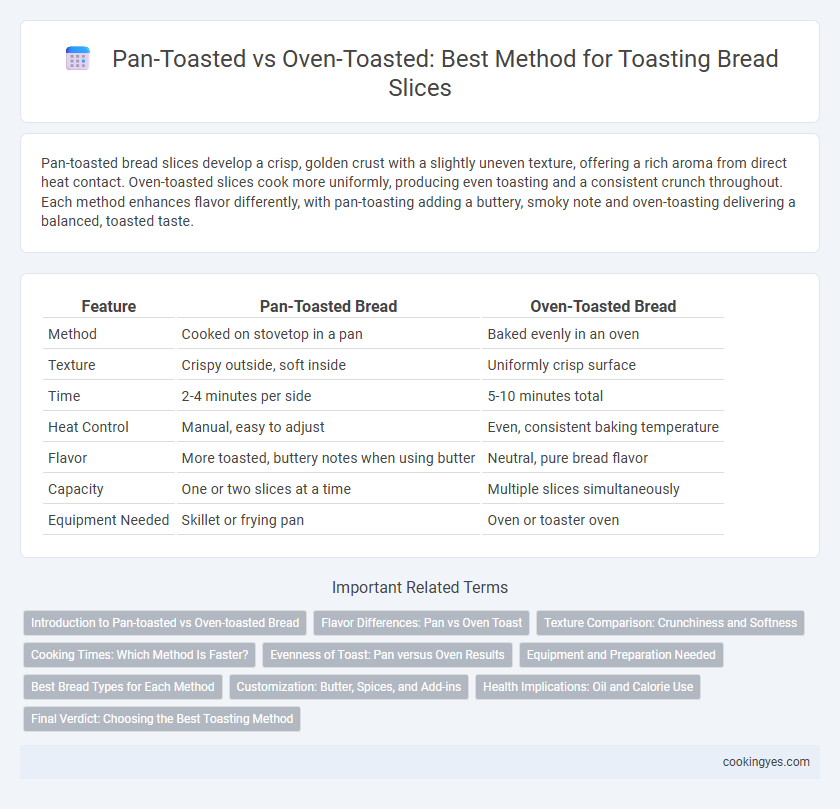Pan-toasted bread slices develop a crisp, golden crust with a slightly uneven texture, offering a rich aroma from direct heat contact. Oven-toasted slices cook more uniformly, producing even toasting and a consistent crunch throughout. Each method enhances flavor differently, with pan-toasting adding a buttery, smoky note and oven-toasting delivering a balanced, toasted taste.
Table of Comparison
| Feature | Pan-Toasted Bread | Oven-Toasted Bread |
|---|---|---|
| Method | Cooked on stovetop in a pan | Baked evenly in an oven |
| Texture | Crispy outside, soft inside | Uniformly crisp surface |
| Time | 2-4 minutes per side | 5-10 minutes total |
| Heat Control | Manual, easy to adjust | Even, consistent baking temperature |
| Flavor | More toasted, buttery notes when using butter | Neutral, pure bread flavor |
| Capacity | One or two slices at a time | Multiple slices simultaneously |
| Equipment Needed | Skillet or frying pan | Oven or toaster oven |
Introduction to Pan-toasted vs Oven-toasted Bread
Pan-toasted bread develops a crispy, golden crust through direct contact with a hot surface, enhancing Maillard reaction flavors and offering a textured exterior with a soft interior. Oven-toasted bread evenly exposes slices to dry heat, creating a uniform crispness ideal for bulk toasting and consistent results. Each method influences the bread's moisture retention and browning intensity, affecting taste and texture preferences.
Flavor Differences: Pan vs Oven Toast
Pan-toasted bread slices develop a rich, caramelized crust through direct contact with a hot surface, enhancing Maillard reactions and producing a deeper, buttery flavor. Oven-toasted bread offers a more even, consistent crispness with subtle, toasted notes and less intense caramelization, preserving the bread's original taste. The choice between pan-toasting and oven-toasting significantly impacts texture and flavor intensity, with pan-toasting emphasizing a robust, nuanced profile and oven-toasting delivering uniform crunch and mild toasty essence.
Texture Comparison: Crunchiness and Softness
Pan-toasted bread slices develop a crisp, unevenly charred texture with a crunchy exterior and a tender interior due to direct contact with heat. Oven-toasted bread achieves a more uniform crunchiness throughout, maintaining consistent softness inside as hot air circulates evenly. The pan-toasting method offers varied texture contrasts, while oven-toasting ensures a balanced crunch and softness in every bite.
Cooking Times: Which Method Is Faster?
Pan-toasted bread slices cook significantly faster than oven-toasted ones, typically taking only 2 to 4 minutes per side due to direct heat contact. Oven-toasting requires a longer time, usually 8 to 12 minutes at 350degF (175degC), as heat surrounds the bread evenly but less intensely. This makes pan-toasting ideal for quick preparation, while oven-toasting suits larger batches or even crispness.
Evenness of Toast: Pan versus Oven Results
Pan-toasted bread slices often show uneven browning due to direct contact with the hot surface, causing some areas to char while others remain pale. Oven-toasted bread provides a more consistent heat distribution around each slice, resulting in uniform crispness and color. This evenness in oven-toasting enhances both texture and flavor, making it preferable for achieving perfectly toasted bread.
Equipment and Preparation Needed
Pan-toasted bread requires minimal equipment, typically just a skillet or frying pan, and involves direct heat with occasional flipping to ensure even browning. Oven-toasted slices demand a toaster oven or conventional oven, allowing for batch toasting and consistent temperature control without flipping. Preparation for pan-toasting often includes adding butter or oil for flavor and crispness, whereas oven toasting is usually dry, relying on the oven's circulating heat for uniform texture.
Best Bread Types for Each Method
Pan-toasted bread slices are best suited for denser varieties like sourdough and rye, which develop a crispy crust and retain moisture inside when cooked on a stovetop. Oven-toasted bread excels with lighter types such as white, whole wheat, and brioche, allowing even heat to create a uniform golden-brown texture. Choosing the right bread type enhances flavor and texture depending on whether pan-toasting or oven-toasting is used.
Customization: Butter, Spices, and Add-ins
Pan-toasted bread slices offer precise control over butter melting and spice infusion, allowing for a richly customized flavor profile with options like garlic, cinnamon, or herbs added directly to the pan. Oven-toasted bread provides even, consistent heat ideal for layering toppings like melted cheese or drizzled honey after toasting, supporting diverse add-ins without sogginess. Both methods enable tailored textures and flavors, enhancing the versatility of butter and spice combinations for personalized toast experiences.
Health Implications: Oil and Calorie Use
Pan-toasted bread slices generally require a small amount of oil or butter, which increases calorie intake and fat content compared to oven-toasted bread that uses dry heat without added fats. Oven-toasted bread retains lower calories and less saturated fat, making it a healthier option for those monitoring their dietary fat consumption. Choosing oven-toasting can reduce overall oil absorption, supporting better heart health and weight management.
Final Verdict: Choosing the Best Toasting Method
Pan-toasted bread slices deliver a crisp, buttery crust with enhanced Maillard reaction flavors, ideal for those seeking rich texture and aroma. Oven-toasted bread offers even heat distribution, producing uniformly browned slices perfect for large batches and consistent crispiness. Selecting the best toasting method depends on preference for texture and flavor intensity versus convenience and volume.
Pan-toasted vs Oven-toasted for bread slices Infographic

 cookingyes.com
cookingyes.com